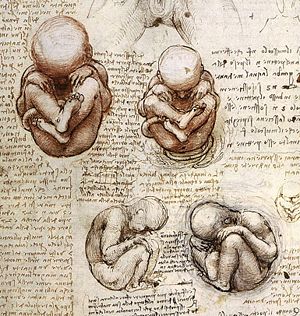Difference between revisions of "Embryology" - New World Encyclopedia
Rick Swarts (talk | contribs) |
(Contracted tag) |
||
| Line 1: | Line 1: | ||
| + | {{Contracted}} | ||
[[Image:Views of a Foetus in the Womb.jpg|thumb|right|300px|"Views of a Foetus in the Womb", [[Leonardo da Vinci]], ca. [[1510]]-[[1512]]. Fetal development is a major subject of developmental biology]] | [[Image:Views of a Foetus in the Womb.jpg|thumb|right|300px|"Views of a Foetus in the Womb", [[Leonardo da Vinci]], ca. [[1510]]-[[1512]]. Fetal development is a major subject of developmental biology]] | ||
Revision as of 16:08, 8 June 2006

Embryology is the branch of developmental biology that studies embryos and their development. Developmental biology is the study of the process by which organisms grow and develop. Modern developmental biology studies the genetic control of cell growth, differentiation and "morphogenesis," which is the process that gives rise to tissues, organs and anatomy. Embryology, a subfield of developmental biololgy, is the study of organisms between the one-cell stage (generally, the zygote) and the end of the embryonic stage, which is not necessarily the beginning of free living. Embryology was originally a more descriptive science until the 20th century. Embryology and developmental biology today deal with the various steps necessary for the correct and complete formation of the body of a living organism.
Overview
Embryology is the classic study of morphological changes within the embryo. Aristotle is described as the first one to do such study, breaking chick eggs after different hours of incubation and observing the ontogeny of the chicken structures. After 50´s, with the DNA structure being created by Watson and Crick, and the increasing knowledge in molecular biology field, developmental biology emerged as the field of study that correlates the genes and such morphological changes; in order words, which genes are responsible for each morphological change that takes place in an embryo. More than explain those morphological changes, to explain how the many different cell types of a multicellular organism arise from the single fertilized cell, the egg, is another aim of developmental biology.
Concepts in embryology
Marcie, I added this section below (and some from the paragraphs above, as well as the image) from the article on Developmental biology in Wikipedia, in order for you to have more to work with. Not all of these concept listed below belong to embryology. Some (such as juvenile, larva, etc.) are for concepts after embryology. However, you can take some of those concepts that belong to embryology and briefly define them and this would flesh out this article more. Remove those that have nothing to do with the subfield of embryology. I also added the section on ontology from the ontology article in Wikipedia, although you will have to decide if, or how much of it, belongs. The original Wikipedia article on embryology was but a paragraph. If you take a definition from another Wikipedia article, please let me know, as I need to credit it.
(really concepts in developmental biology)
- allantois, amnion, blastocyst, blastomere, blastula, blastulation, chorion, chrysalis, cleavage, embryo, embryogenesis, embryogeny, embryology, extra-embryonic membrane, fetus (or foetus), gastrula, gastrulation, germ layer, germ plasm, germination, induction, juvenile, larva, maternal effect, metamorphosis, genome, morphogenesis, morula, neoteny, neural development, nymph, ontogeny, oosperm, ovism, paedogenesis, pangenesis, phylogeny, primordium, pupa, rudiment, seed, self-organization, teratology, zygote
Ontogeny
Ontogeny (also ontogenesis or morphogenesis) describes the origin and the development of an organism from the fertilized egg to its mature form. Ontogeny is studied in developmental biology.
The idea that ontogeny recapitulates phylogeny, that is, that the development of an organism exactly mirrors the evolutionary development of the species, is discredited today. However the phenomenon of recapitulation, in which a developing organism will for a time show a similar trait or attribute to that of an ancestral species, only to have it disappear at a later stage is well documented. For example, embryos of the baleen whale still develop teeth at certain embryonic stages, only to later disappear. A more general example is the emergence of pharyngeal gill pouches of lower vertebrates in almost all mammalian embryos at early stages of development. (April, 2001)
ReferencesISBN links support NWE through referral fees
- UNSW Embryology Huge resource of information and media
Embryology|56745817|Ontogeny|56250223|Developmental_biology|52031826